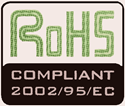1.7: RoHS
- Page ID
- 31636
Electrical components are not without a downside. Some devices potentially may contain hazardous substances such as toxic metals. Even if the devices are constructed and used with care, these substances can still create life cycle issues; that is, when their useful life is over, simply “throwing them away” can create environmental contamination.
In the early 2000s the European Union ratified the RoHS Directive. This stands for the Restriction of Hazardous Substances, and controls the use of several materials used in the construction of electrical and electronic systems. These materials include lead, mercury, cadmium, hexavalent chromium (used in chrome plating), and other specific chemicals such as certain flame retardants and plasticizers. The RoHS Directive specifies the amount of these materials allowed in any homogeneous material that makes up the device or product. Homogeneous materials, are, in essence, the smallest parts that could be separated mechanically. Examples would be items such as a machine screw, the toggle lever of a switch, or the magnet of a loudspeaker. Each of these items must individually meet the limits set by the directive. Most of these substances have limits of 1000 ppm (parts per million) although cadmium (used in rechargeable Ni-Cd batteries and certain light detectors) has a limit of 100 ppm.
The RoHS Directive has been updated periodically. The third variation (RoHS 3) became effective in the summer of 2019. Related to RoHS is WEEE, which stands for Waste from Electrical and Electronic Equipment. This controls the recovery and recycling of these devices. Generally, products sold in the EU market must meet the WEEE requirements. Several countries outside of the EU have adopted similar requirements including Japan, China, South Korea and Turkey. The USA has not adopted RoHS per se, however, several US states have adopted “RoHS-like” requirements, including California, Colorado and New York. With increasing environmental consciousness, it is likely that more countries will adopt similar measures.
To help electronic and electrical system designers make their products meet the RoHS requirements, electrical component manufacturers often use some manner of “RoHS compliant” logo or statement on their data sheets. There is no standard for these logos, however, a finished product will bear the standard RoHS compliance label, as shown in Figure 1.7.1 .

Figure 1.7.1 : RoHS compliance label.


